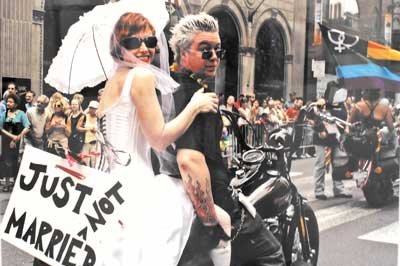Photographer Joan Roth has spent more than four decades documenting the lives of Jewish women, traveling to regions as far-flung as Ethiopia and Ukraine to capture evocative images. Yet, at times, Roth has been able to broaden viewers’ understanding of gender, Judaism and sexuality without leaving her hometown, New York City.
That’s certainly the case with her radiant portrait of a smiling Joy Ladin, the first transgender woman on the faculty of Yeshiva University. It also holds true for “Dyke Parade,” her snapshot of a mischievous butch-femme couple riding a motorcycle during a recent Pride event in Manhattan.
Those images are among the works on display in “The Sexuality Spectrum,” an exhibit at the Philadelphia Museum of Jewish Art, which is part of Congregation Rodeph Shalom, 615 N. Broad St. Admission to the show is free and it runs through Nov. 18.
“The Sexuality Spectrum” is a traveling exhibit that was originally organized by Laura Kruger, curator of the museum at Hebrew Union College in New York. Its initial run, which ended in June, featured 112 pieces by 69 artists. The Philadelphia Museum of Jewish Art is the traveling exhibit’s first stop in what Kruger hopes will be a long tour around the country.
Wendi Furman, PMJA director of exhibitions, personally selected almost 30 pieces for the Philadelphia show. The 20 artists represented are scattered across the Kinsey Scale — gay, straight and queer — but all of their work reflects on Judaism and sexuality, with both categories broadly defined.
Just as the artists approach those themes from different perspectives, they also employ a variety of media to do so, including photography, painting and textiles.
“For me, it’s always about the artwork first,” Furman said. “But one of the themes that’s always in my head as a curator at a Jewish museum is Jewish diversity.”
Among Furman’s considerations were how to balance a broad range of representations of sexuality with the needs of a diverse constituency, including everyone from congregants to the general public, and students to senior citizens. Rodeph Shalom is also affiliated with Beth Ahavah, which serves the local Jewish LGBT community.
That diversity is expressed in various ways. Some artists, such as Archie Rand, refer to significant figures from Scripture. In his vibrant 2012 painting “Deborah Diptych,” the female prophet and warrior from the Book of Judges is given a contemporary makeover, including a helmet, uniform and rifle. In his depiction, reminiscent of R. Crumb, Deborah’s ample bosom and long hair signify her femininity, but her muscular forearms and confident attitude leave no doubt as to her toughness.
Photographer Albert Winn takes a different approach, focusing on his life as a gay Jewish man living with AIDS. In 1990, shortly after receiving his diagnosis, Winn began a series called “My Life Until Now.” That longterm project is represented by the 1995 photograph “Akedah,” a Hebrew word that refers to the binding of Isaac. In juxtaposing concrete, recognizable images of both his faith and his illness, the photographer invokes the ideas of martyrdom, self-sacrifice and sons implied in the title.
The show’s initial exhibition included abstract and impressionistic artwork, but the local emphasis is on portraits. Viewers are either looking at subjects who are looking back at them or who, observed unawares, are clearly comfortable with themselves.
“It was about putting a human face on this and embracing diversity, being inclusive and advocating for civil rights,” Furman said.
A good example is Sid Kaplan’s portrait of Allen Ginsberg and Peter Orlovsky, who smile at viewers fortunate to get a glimpse of their bohemian domesticity.
Photographer Joshua Lehrer’s 2009 piece “Tinaya and Family” focuses on five teenagers huddled close together, suggesting the happiness and security of family; in reality, they are part of New York’s growing population of homeless LGBT youth.
The issue of family actually plays a significant role in “The Sexuality Spectrum,” which was originally conceived as a response to the sometimes-negative tone of the debate about marriage equality.
“In May 2011, the Marriage Equality Act was being argued in the New York state legislature,” explained Kruger. “Frequently the rhetoric was unrestrained, out of context, derogatory and threatening. It had faint echoes in my inner ear of the type of hate language that was spewed about by the Nazi Party in building fervor to begin the elimination of Jews during the 1930s.”
Kruger’s response was to engage artists whose work showed evidence of firm commitment to aesthetics and social justice in a conversation about gender and sexuality, and to seek out new and unfamiliar work.
The result, even in the smaller version on display at PMJA, celebrates the broad range of human sexuality and should stimulate thought among all viewers, Jewish and Christian, straight and queer.
For more information, visit www.rodephshalom.org/pmja_current.
